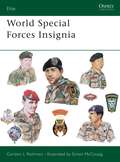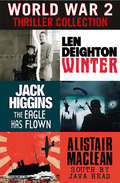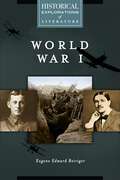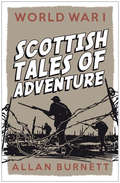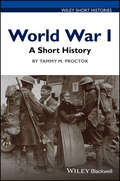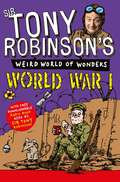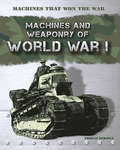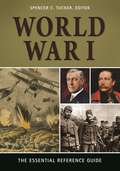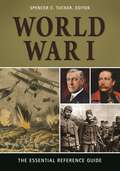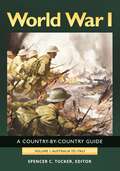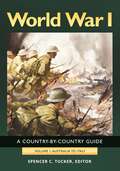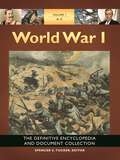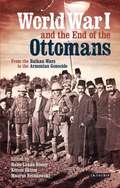- Table View
- List View
World Special Forces Insignia (Elite #22)
by Gordon L. RottmanThere exists among the world's armies a proliferation of special forces groups. Today's smaller armies, especially those of developing nations, demand maximum efficiency in force structure and employment. Mountain, jungle, arctic and desert areas require special purpose units trained, conditioned, and equipped to master these environments. This volume by ex-weapons specialist in the US 7th Special Forces Group, Gordon L. Rottman, details the insignia of a myriad of special forces groups from all parts of the globe, from Portugal's Commando Regiment to the North Yemen 'Al Mithalaat' Brigade, with a wealth of illustrations and photographs, including 12 full page colour plates by Simon McCouaig.
World Special Forces Insignia (Elite)
by Gordon L. Rottman Simon McCouaigThere exists among the world's armies a proliferation of special forces groups. Today's smaller armies, especially those of developing nations, demand maximum efficiency in force structure and employment. Mountain, jungle, arctic and desert areas require special purpose units trained, conditioned, and equipped to master these environments. This volume by ex-weapons specialist in the US 7th Special Forces Group, Gordon L. Rottman, details the insignia of a myriad of special forces groups from all parts of the globe, from Portugal's Commando Regiment to the North Yemen 'Al Mithalaat' Brigade, with a wealth of illustrations and photographs, including 12 full page colour plates by Simon McCouaig.
The World War 1939–1945: The Cartoonists' Vision (Routledge Library Editions: WW2 #47)
by Roy DouglasThis new approach to the history of the Second World War, first published in 1990, examines the events of this period through the cartoons of the day. Roy Douglas explains the messages behind the humour and reveals that the perception of war differed radically from country to country. This collection highlights the importance of the media in this global war. ‘An authoritative narrative about what inspired the artists to take to their pens and papers… By putting it all into perspective, the poignancy, and often the brilliance of the political cartoonist is shown to the reader… Douglas’s historical narrative adds to the enjoyment.’ West Coast Review of Books ‘Douglas’s valuable book uses the political cartoon as historical mirror… The book is very important for its attempt to correlate visual media with national policy at a crucial period in recent history.’ Choice
The World War 1939–1945: The Cartoonists' Vision (Routledge Library Editions: WW2 #47)
by Roy DouglasThis new approach to the history of the Second World War, first published in 1990, examines the events of this period through the cartoons of the day. Roy Douglas explains the messages behind the humour and reveals that the perception of war differed radically from country to country. This collection highlights the importance of the media in this global war. ‘An authoritative narrative about what inspired the artists to take to their pens and papers… By putting it all into perspective, the poignancy, and often the brilliance of the political cartoonist is shown to the reader… Douglas’s historical narrative adds to the enjoyment.’ West Coast Review of Books ‘Douglas’s valuable book uses the political cartoon as historical mirror… The book is very important for its attempt to correlate visual media with national policy at a crucial period in recent history.’ Choice
World War 2 and the Soviet People: Selected Papers from the Fourth World Congress for Soviet and East European Studies, Harrogate, 1990
by John Garrard Alison Healicon"Selected papers from the Fourth World Congress for Soviet and East European Studies, Harrogate, 1990."
World War 2 Thriller Collection: Winter, The Eagle Has Flown, South By Java Head
by Len Deighton Jack Higgins Alistair MacLeanPresented for the first time, three classic war novels from the generals of the genre, Len Deighton, Jack Higgins & Alistair MacLean.
World War I: A Historical Exploration of Literature (Historical Explorations of Literature)
by Eugene Edward BeirigerFocusing on the war on the Western and Southern fronts and inclusive of material from all sides of the conflict, this book explores the novels and poems of significant soldier-writers alongside important contemporary historical documents.The literary works of the First World War are one of the richest sources we have for understanding one of the twentieth century's most significant conflicts. Not only do many of them have historical merit, but some were critically acclaimed by both contemporaries and subsequent scholars. For example, Henri Barbusse's Under Fire, one of the earliest novels of the war, won accolades in France and the respect of war poets Siegfried Sassoon and Wilfred Owen as well as novelists Erich Maria Remarque and Ernest Hemingway.This book examines these works and those of war poets Rupert Brooke and John McCrae and others, providing context as well as opportunities to explore thematic elements with primary source documents, such as diaries, letters, memoirs, newspaper and journal articles, speeches, and government publications. It is unique in its use of literary and historical sources as mediums by which to both better understand the literature of the war and use literature to better understand the war itself.
World War I: A Historical Exploration of Literature (Historical Explorations of Literature)
by Eugene Edward BeirigerFocusing on the war on the Western and Southern fronts and inclusive of material from all sides of the conflict, this book explores the novels and poems of significant soldier-writers alongside important contemporary historical documents.The literary works of the First World War are one of the richest sources we have for understanding one of the twentieth century's most significant conflicts. Not only do many of them have historical merit, but some were critically acclaimed by both contemporaries and subsequent scholars. For example, Henri Barbusse's Under Fire, one of the earliest novels of the war, won accolades in France and the respect of war poets Siegfried Sassoon and Wilfred Owen as well as novelists Erich Maria Remarque and Ernest Hemingway.This book examines these works and those of war poets Rupert Brooke and John McCrae and others, providing context as well as opportunities to explore thematic elements with primary source documents, such as diaries, letters, memoirs, newspaper and journal articles, speeches, and government publications. It is unique in its use of literary and historical sources as mediums by which to both better understand the literature of the war and use literature to better understand the war itself.
World War I: Scottish Tales of Adventure
by Allan BurnettAcclaimed children's author Allan Burnett turns his attention to the First World War in a book of explosively exciting and emotionally charged tales of bravery and adventure. Featuring the true exploits of soldiers, spies, pilots, sailors and many others, these stories, all based on interviews with these heroes themselves or their descendants, offer a unique, personal insight into the First World War that no conventional history book can ever hope to match.
World War I: World War I Ebook (What They Don't Tell You About)
by Robert FowkeThis book explains how the war started, what it was about and who it involved. It describes the major battles and looks at what life was like for the soldiers in the trenches, the pilots in the air, the sailors at sea and the civilians back home.Written in the lively style common to this series, the author deals with this difficult subject in a sensitive and skilful manner, introducing humour only where appropriate. With black line illustrations throughout.
World War I (Greenwood Press Guides to Historic Events of the Twentieth Century)
by Neil HeymanRead the experiences of the men and women who served in a horrific war, across the sea-the Great War. Relying extensively on letters, diaries, and reminiscences of those Americans who fought or served in World War I, Jennifer Keene reports on training and camp requirements for enlistees and recruits; the details of the transport across the ocean of sailors, soldiers, and others being carried Over There; and the experiences of African Americans, women, Native Americans and immigrants in The White Man's Army. She also describes in vivid detail, The Sailor's War, and for those on the ground in France and Belgium, the events of static trench warfare, and movement combat. Chapters describe coping with and treating disease and wounds; the devastating amount of death; and for those who came home, the veterans' difficult entrances back into civilian life. A timeline, extensive bibliography or recommended sources, and illustrations add to the usefulness of the volume
World War I (The Greenwood Press Daily Life Through History Series: American Soldiers' Lives)
by Jennifer D. KeeneRead the experiences of the men and women who served in a horrific war, across the sea-the Great War. Relying extensively on letters, diaries, and reminiscences of those Americans who fought or served in World War I, Jennifer Keene reports on training and camp requirements for enlistees and recruits; the details of the transport across the ocean of sailors, soldiers, and others being carried Over There; and the experiences of African Americans, women, Native Americans and immigrants in The White Man's Army. She also describes in vivid detail, The Sailor's War, and for those on the ground in France and Belgium, the events of static trench warfare, and movement combat. Chapters describe coping with and treating disease and wounds; the devastating amount of death; and for those who came home, the veterans' difficult entrances back into civilian life. A timeline, extensive bibliography or recommended sources, and illustrations add to the usefulness of the volume
World War I: A Short History (Wiley Short Histories)
by Tammy M. ProctorA lively, engaging history of The Great War written for a new generation of readers In recent years, scholarship on World War I has turned from a fairly narrow focus on military tactics, weaponry, and diplomacy to incorporate considerations of empire, globalism, and social and cultural history. This concise history of the first modern, global war helps to further broaden the focus typically provided in World War I surveys by challenging popular myths and stereotypes to provide a new, engaging account of The Great War. The conventional World War I narrative that has evolved over the past century is that of an inevitable but useless war, where men were needlessly slaughtered due to poor decisions by hidebound officers. This characterization developed out of a narrow focus on the Western Front promulgated mainly by British historians. In this book, Professor Proctor provides a broader, more multifaceted historical narrative including perspectives from other fronts and spheres of interest and a wider range of participants. She also draws on recent scholarship to consider the gendered aspect of war and the ways in which social class, religion, and cultural factors shaped experiences and memories of the war. Structured chronologically to help convey a sense of how the conflict evolved Each chapter considers a key interpretive question, encouraging readers to examine the extent to which the war was total, modern, and global Challenges outdated stereotypes created through a focus on the Western Front Considers the war in light of recent scholarship on empire, global history, gender, and culture Explores ways in which the war and the terms of peace shaped the course of the 20th century World War I: A Short History is sure to become required reading in undergraduate survey courses on WWI, as well as courses in military history, the 20th century world, or the era of the World Wars.
World War I: A Short History (Wiley Short Histories)
by Tammy M. ProctorA lively, engaging history of The Great War written for a new generation of readers In recent years, scholarship on World War I has turned from a fairly narrow focus on military tactics, weaponry, and diplomacy to incorporate considerations of empire, globalism, and social and cultural history. This concise history of the first modern, global war helps to further broaden the focus typically provided in World War I surveys by challenging popular myths and stereotypes to provide a new, engaging account of The Great War. The conventional World War I narrative that has evolved over the past century is that of an inevitable but useless war, where men were needlessly slaughtered due to poor decisions by hidebound officers. This characterization developed out of a narrow focus on the Western Front promulgated mainly by British historians. In this book, Professor Proctor provides a broader, more multifaceted historical narrative including perspectives from other fronts and spheres of interest and a wider range of participants. She also draws on recent scholarship to consider the gendered aspect of war and the ways in which social class, religion, and cultural factors shaped experiences and memories of the war. Structured chronologically to help convey a sense of how the conflict evolved Each chapter considers a key interpretive question, encouraging readers to examine the extent to which the war was total, modern, and global Challenges outdated stereotypes created through a focus on the Western Front Considers the war in light of recent scholarship on empire, global history, gender, and culture Explores ways in which the war and the terms of peace shaped the course of the 20th century World War I: A Short History is sure to become required reading in undergraduate survey courses on WWI, as well as courses in military history, the 20th century world, or the era of the World Wars.
World War I: World War I And World War Ii (Sir Tony Robinson's Weird World of Wonders #1)
by Sir Tony RobinsonIn Sir Tony Robinson's Weird World of Wonders World War I Tony Robinson takes you on a headlong gallop through time, pointing out all the most important, funny, strange, amazing, entertaining, smelly and disgusting bits about World War I. It's history, but not as we know it!Find out everything you ever needed to know about World War I in this brilliant action-packed, fact-filled book, including:- How to build a trench- Why dogs were such good messengers- How plastic surgery was invented- Why you needed a gas maskWhat are you waiting for? Let's get going . . .For more World War history facts in this fun series, discover World War II.
World War I (Machines that Won the War)
by Charlie SamuelsAs well as bravery, leadership and luck, wars have always been decided by technology. This book looks at the weapons, armour and fighting hardware that made the difference in World War I. Twenty signficant vehicles, ships or weapons are described and the specific actions in which they played a decisive part. Combines concise reliable technical specifications with eyewitness accounts and quotes from the people who used the machines.Includes a timeline placing the weapons in the context of war.
World War I: The Essential Reference Guide
by Spencer C. Tucker, EditorWith its authoritative reference entries, multiple introductory and perspective essays, primary source documents, detailed chronology, and bibliography, this single-volume reference provides all the key information readers need to understand this monumental conflict.World War I was an epic conflict that toppled centuries-old empires, transformed the Middle East and Russia, and helped elevate the United States to prominence as a world power. In essence, understanding the reasons for and outcomes of the First World War provides a cornerstone for knowledge of all modern history. In World War I: The Essential Reference Guide, detailed reference entries, a comprehensive overview essay, plus additional examinations of the causes and consequences of the conflict provide readers with the context needed to understand all aspects of World War I.Important primary source documents like the Zimmerman Telegram and Balfour Declaration are included and accompanied by explanations that supply readers with key historical perspective. Biographies on major political and military leaders, such as Wilhelm II, Woodrow Wilson, Nicholas II, John Pershing, and Ferdinand Foch, offer insight into the people who played key roles in the conflict. Entries on the key confrontations of the war—many accompanied by maps—showcase the strategies of both sides in their attempts to emerge victorious, and the bibliography presents a wealth of options to students looking to conduct further research on World War I.
World War I: The Essential Reference Guide
by Spencer C. TuckerWith its authoritative reference entries, multiple introductory and perspective essays, primary source documents, detailed chronology, and bibliography, this single-volume reference provides all the key information readers need to understand this monumental conflict.World War I was an epic conflict that toppled centuries-old empires, transformed the Middle East and Russia, and helped elevate the United States to prominence as a world power. In essence, understanding the reasons for and outcomes of the First World War provides a cornerstone for knowledge of all modern history. In World War I: The Essential Reference Guide, detailed reference entries, a comprehensive overview essay, plus additional examinations of the causes and consequences of the conflict provide readers with the context needed to understand all aspects of World War I.Important primary source documents like the Zimmerman Telegram and Balfour Declaration are included and accompanied by explanations that supply readers with key historical perspective. Biographies on major political and military leaders, such as Wilhelm II, Woodrow Wilson, Nicholas II, John Pershing, and Ferdinand Foch, offer insight into the people who played key roles in the conflict. Entries on the key confrontations of the war—many accompanied by maps—showcase the strategies of both sides in their attempts to emerge victorious, and the bibliography presents a wealth of options to students looking to conduct further research on World War I.
World War I [2 volumes]: A Country-by-Country Guide [2 volumes]
by Spencer C. TuckerOffers detailed coverage of every country that played a significant role in World War I, from key participants including France, Germany, Great Britain, the Ottoman Empire, and the United States, to smaller nations such as Bulgaria, Montenegro, and New Zealand.World War I: A Country-by-Country Guide is a comprehensive reference exploring the role various nations played in this devastating conflict. Each of the 22 country sections provides detailed background information, the reasons behind the country's entry into the war, a summary of its combat effort in the war, a discussion of the home front experience, and a description of the war's impact on that nation. Illuminating sidebars offer an interesting war anecdote involving each country, while essays survey each country's military branches and key military and political leaders. Finally, a timeline for each nation covers all of the important events involving that country during World War I. In addition to the country coverage, a battles section offers entries on 18 of World War I's most important engagements and a separate section on weapons and tactical changes is included. The book also features dozens of maps and images throughout the text that serve as important visual aids that help readers to understand all aspects of the conflict.
World War I [2 volumes]: A Country-by-Country Guide [2 volumes]
by Spencer C. TuckerOffers detailed coverage of every country that played a significant role in World War I, from key participants including France, Germany, Great Britain, the Ottoman Empire, and the United States, to smaller nations such as Bulgaria, Montenegro, and New Zealand.World War I: A Country-by-Country Guide is a comprehensive reference exploring the role various nations played in this devastating conflict. Each of the 22 country sections provides detailed background information, the reasons behind the country's entry into the war, a summary of its combat effort in the war, a discussion of the home front experience, and a description of the war's impact on that nation. Illuminating sidebars offer an interesting war anecdote involving each country, while essays survey each country's military branches and key military and political leaders. Finally, a timeline for each nation covers all of the important events involving that country during World War I. In addition to the country coverage, a battles section offers entries on 18 of World War I's most important engagements and a separate section on weapons and tactical changes is included. The book also features dozens of maps and images throughout the text that serve as important visual aids that help readers to understand all aspects of the conflict.
World War I [5 volumes]: The Definitive Encyclopedia and Document Collection [5 volumes]
by Spencer C. TuckerOffering exhaustive coverage, detailed analyses, and the latest historical interpretations of events, this expansive, five-volume encyclopedia is the most comprehensive and detailed reference source on the First World War available today.One hundred years after the beginning of World War I in 1914, this conflict still stands as perhaps the most important event of the 20th century. World War I toppled all of the existing empires at the time, transformed the Middle East, and vaulted the United States to becoming the world's leading economic power. Its effects were profound and lasting—and included outcomes that led to World War II. This multivolume encyclopedia provides a wide-ranging examination of World War I that covers all of the important battles; key individuals, both civilian and military; weapons and technologies; and diplomatic, social, political, cultural, military, and economic developments.Suitable as a reference tool for high school and undergraduate students as well as faculty members and graduate-level researchers, World War I: The Definitive Encyclopedia and Document Collection offers accessible, in-depth information and up-to-date analyses in a format that lends itself to quick and easy use. The set comprises alphabetically arranged, cross-referenced entries accompanied by further reading selections as well as a comprehensive bibliography. A fifth volume provides chronologically arranged documents and an A–Z index.
World War I [5 volumes]: The Definitive Encyclopedia and Document Collection [5 volumes]
Offering exhaustive coverage, detailed analyses, and the latest historical interpretations of events, this expansive, five-volume encyclopedia is the most comprehensive and detailed reference source on the First World War available today.One hundred years after the beginning of World War I in 1914, this conflict still stands as perhaps the most important event of the 20th century. World War I toppled all of the existing empires at the time, transformed the Middle East, and vaulted the United States to becoming the world's leading economic power. Its effects were profound and lasting—and included outcomes that led to World War II. This multivolume encyclopedia provides a wide-ranging examination of World War I that covers all of the important battles; key individuals, both civilian and military; weapons and technologies; and diplomatic, social, political, cultural, military, and economic developments.Suitable as a reference tool for high school and undergraduate students as well as faculty members and graduate-level researchers, World War I: The Definitive Encyclopedia and Document Collection offers accessible, in-depth information and up-to-date analyses in a format that lends itself to quick and easy use. The set comprises alphabetically arranged, cross-referenced entries accompanied by further reading selections as well as a comprehensive bibliography. A fifth volume provides chronologically arranged documents and an A–Z index.
World War I and the End of the Ottomans: From the Balkan Wars to the Armenian Genocide
by Hans-Lukas Kieser Kerem Oktem Maurus ReinkowskiWith the end of the First World War, the centuries-old social fabric of the Ottoman world an entangled space of religious co-existence throughout the Balkans and the Middle East came to its definitive end. In this new study, Hans-Lukas Kieser argues that while the Ottoman Empire officially ended in 1922, when the Turkish nationalists in Ankara abolished the Sultanate, the essence of its imperial character was destroyed in 1915 when the Young Turk regime eradicated the Armenians from Asia Minor. This book analyses the dynamics and processes that led to genocide and left behind today s crisis-ridden post-Ottoman Middle East. Going beyond Istanbul, the book also studies three different but entangled late Ottoman areas: Palestine, the largely Kurdo-Armenian eastern provinces and the Aegean shores; all of which were confronted with new claims from national movements that questioned the Ottoman state. All would remain regions of conflict up to the present day.Using new primary material, World War I and the End of the Ottoman World brings together analysis of the key forces which undermined an empire, and marks an important new contribution to the study of the Ottoman world and the Middle East."
World War I and the End of the Ottomans: From the Balkan Wars to the Armenian Genocide (Library of Ottoman Studies)
by Hans-Lukas Kieser Kerem Oktem Maurus ReinkowskiWith the end of the First World War, the centuries-old social fabric of the Ottoman world - an entangled space of religious co-existence throughout the Balkans and the Middle East - came to its definitive end. In this new study, Hans-Lukas Kieser argues that while the Ottoman Empire officially ended in 1922, when the Turkish nationalists in Ankara abolished the Sultanate, the essence of its imperial character was destroyed in 1915 when the Young Turk regime eradicated the Armenians from Asia Minor. This book analyses the dynamics and processes that led to genocide and left behind today's crisis-ridden post-Ottoman Middle East. Going beyond Istanbul, the book also studies three different but entangled late Ottoman areas: Palestine, the largely Kurdo-Armenian eastern provinces and the Aegean shores; all of which were confronted with new claims from national movements that questioned the Ottoman state. All would remain regions of conflict up to the present day. Using new primary material, World War I and the End of the Ottoman World brings together analysis of the key forces which undermined an empire, and marks an important new contribution to the study of the Ottoman world and the Middle East.
World War I and the Jews: Conflict and Transformation in Europe, the Middle East, and America
by Marsha L. Rozenblit and Jonathan KarpWorld War I utterly transformed the lives of Jews around the world: it allowed them to display their patriotism, to dispel antisemitic myths about Jewish cowardice, and to fight for Jewish rights. Yet Jews also suffered as refugees and deportees, at times catastrophically. And in the aftermath of the war, the replacement of the Habsburg Monarchy and the Russian and Ottoman Empires with a system of nation-states confronted Jews with a new set of challenges. This book provides a fascinating survey of the ways in which Jewish communities participated in and were changed by the Great War, focusing on the dramatic circumstances they faced in Europe, North America, and the Middle East during and after the conflict.
